Radiation Response of Large-Area 4H-SiC Schottky Barrier Diodes
Abstract
1. Introduction
2. Materials and Methods
3. Results
3.1. Electrical Characteristics of 4H-SiC Detector
3.2. Radiation Response to Alpha Particles
3.3. Radiation Response to Thermal Neutrons
4. Discussion
5. Conclusions
Author Contributions
Funding
Institutional Review Board Statement
Informed Consent Statement
Data Availability Statement
Conflicts of Interest
References
- Bernat, R.; Bakrač, L.; Radulović, V.; Snoj, L.; Makino, T.; Ohshima, T.; Pastuović, Ž.; Capan, I. 4H-SiC Schottky Barrier Diodes for Efficient Thermal Neutron Detection. Materials 2021, 14, 5105. [Google Scholar] [CrossRef] [PubMed]
- Kimoto, T.; Cooper, J.A. Fundamentals of Silicon Carbide Technology; John Wiley & Sons: Hoboken, NJ, USA, 2014; ISBN 9781118313527. [Google Scholar]
- Radulović, V.; Yamazaki, Y.; Pastuović, Ž.; Sarbutt, A.; Ambrožič, K.; Bernat, R.; Ereš, Z.; Coutinho, J.; Ohshima, T.; Capan, I.; et al. Silicon carbide neutron detector testing at the JSI TRIGA reactor for enhanced border and port security. Nucl. Instrum. Methods Phys. Res. Sect. A Accel. Spectrometers Detect. Assoc. Equip. 2020, 972, 164122. [Google Scholar] [CrossRef]
- Coutinho, J.; Torres, V.J.; Capan, I.; Brodar, T.; Ereš, Z.; Bernat, R.; Radulović, V.; Ambrožič, K.; Snoj, L.; Pastuović, Z.; et al. Silicon carbide diodes for neutron detection. Nucl. Inst. Methods Phys. Res. A 2020, 986, 164793. [Google Scholar] [CrossRef]
- Wright, N.; Horsfall, A.B. SiC sensors: A review. J. Phys. D Appl. Phys. 2007, 40, 6345–6354. [Google Scholar] [CrossRef]
- Ruddy, F.; Dulloo, A.; Seidel, J.; Seshadri, S.; Rowland, L. Development of a silicon carbide radiation detector. IEEE Trans. Nucl. Sci. 1998, 45, 536–541. [Google Scholar] [CrossRef]
- Seshadri, S.; Dulloo, A.; Ruddy, F.; Seidel, J.; Rowland, L. Demonstration of an SiC neutron detector for high-radiation environments. IEEE Trans. Electron Devices 1999, 46, 567–571. [Google Scholar] [CrossRef]
- Ruddy, F.H. Silicon Carbide Radiation Detectors: Progress, Limitations and Future Directions. Int. J. Microw. Wirel. Technol. 2013, 1576, 1142. [Google Scholar] [CrossRef]
- Kalinina, E.V.; Ivanov, A.M.; Strokan, N.B. Performance of p-n 4H-SiC film nuclear radiation detectors for operation at elevated temperatures (375 °C). Tech. Phys. Lett. 2008, 34, 210–212. [Google Scholar] [CrossRef]
- Rao, S.; Pangallo, G.; Della Corte, F.G. 4H-SiC p-i-n diode as Highly Linear Temperature Sensor. IEEE Trans. Electron Devices 2016, 63, 414–418. [Google Scholar] [CrossRef]
- Capan, I. 4H-SiC Schottky Barrier Diodes as Radiation Detectors: A Review. Electronics 2022, 11, 532. [Google Scholar] [CrossRef]
- Ruddy, F.; Seidel, J.; Chen, H.; Dulloo, A.; Ryu, S.-H. High-resolution alpha-particle spectrometry using 4H silicon carbide semiconductor detectors. IEEE Trans. Nucl. Sci. 2006, 53, 1713–1718. [Google Scholar] [CrossRef]
- Bernat, R.; Capan, I.; Bakrač, L.; Brodar, T.; Makino, T.; Ohshima, T.; Pastuović, Z.; Sarbutt, A. Response of 4H-SiC Detectors to Ionizing Particles. Crystals 2021, 11, 10. [Google Scholar] [CrossRef]
- Kleppinger, J.W.; Chaudhuri, S.K.; Karadavut, O.; Mandal, K.C. Defect characterization and charge transport measurements in high-resolution Ni/n-4H-SiC Schottky barrier radiation detectors fabricated on 250 μm epitaxial layers. J. Appl. Phys. 2021, 129, 244501. [Google Scholar] [CrossRef]
- Flammang, R.W.; Seidel, J.G.; Ruddy, F.H. Fast neutron detection with silicon carbide semiconductor radiation detectors. Nucl. Instrum. Methods Phys. Res. Sect. A Accel. Spectrometers Detect. Assoc. Equip. 2007, 579, 177–179. [Google Scholar] [CrossRef]
- Lees, J.E.; Bassford, D.J.; Fraser, G.W.; Horsfall, A.B.; Vassilevski, K.V.; Wright, N.G.; Owens, A. Semi-transparent SiC Schottky diodes for X-ray spectroscopy. Nucl. Instrum. Methods Phys. Res. Sect. A Accel. Spectrometers Detect. Assoc. Equip. 2007, 578, 226–234. [Google Scholar] [CrossRef]
- Zaťko, B.; Hrubčín, L.; Šagátová, A.; Osvald, J.; Boháček, P.; Kováčová, E.; Halahovets, Y.; Rozov, S.V.; Sandukovskij, V. Study of Schottky barrier detectors based on a high quality 4H-SiC epitaxial layer with different thickness. Appl. Surf. Sci. 2020, 536, 147801. [Google Scholar] [CrossRef]
- Manfredotti, C.; Giudice, A.L.; Fasolo, F.; Vittone, E.; Paolini, C.; Fizzotti, F.; Zanini, A.; Wagner, G.; Lanzieri, C. SiC detectors for neutron monitoring. Nucl. Instrum. Methods Phys. Res. Sect. A Accel. Spectrometers Detect. Assoc. Equip. 2005, 552, 131–137. [Google Scholar] [CrossRef]
- Kim, H.S.; Ha, J.H.; Park, S.-H.; Lee, S.W.; Moon, M.K.; Sun, G.-M.; Lee, C.H. Characteristics of Fabricated Neutron Detectors Based on a SiC Semiconductor. J. Nucl. Sci. Technol. 2011, 48, 1343–1347. [Google Scholar] [CrossRef]
- McGregor, D.S.; Hammig, M.D.; Yang, Y.H.; Gersch, H.K.; Klann, R.T. Design considerations for thin film coated semiconductor thermal neutron detectors—I: Basics regarding alpha particle emitting neutron reactive films. Nucl. Instrum. Methods Phys. Res. Sect. A Accel. Spectrometers Detect. Assoc. Equip. 2003, 500, 272–308. [Google Scholar] [CrossRef]
- Sedlačková, K.; Zat’Ko, B.; Šagátová, A.; Nečas, V.; Boháček, P.; Sekáčová, M. Comparison of semi-insulating GaAs and 4H-SiC-based semiconductor detectors covered by LiF film for thermal neutron detection. Appl. Surf. Sci. 2018, 461, 242–248. [Google Scholar] [CrossRef]
- Mandic, I.; Cindro, V.; Gorisek, A.; Kramberger, G.; Mikuz, M. Online Integrating Radiation Monitoring System for the ATLAS Detector at the Large Hadron Collider. IEEE Trans. Nucl. Sci. 2007, 54, 1143–1150. [Google Scholar] [CrossRef]
- Mandic, I.; Cindro, V.; Kramberger, G.; Kristof, E.; Mikuz, M.; Vrtacnik, D.; Ullan, M.; Anghinolfi, F. Bulk damage in DMILL npn bipolar transistors caused by thermal neutrons versus protons and fast neutrons. IEEE Trans. Nucl. Sci. 2004, 51, 1752–1758. [Google Scholar] [CrossRef]
- Ambrožič, K.; Žerovnik, G.; Snoj, L. Computational analysis of the dose rates at JSI TRIGA reactor irradiation facilities. Appl. Radiat. Isot. 2017, 130, 140–152. [Google Scholar] [CrossRef] [PubMed]
- Snoj, L.; Žerovnik, G.; Trkov, A. Computational analysis of irradiation facilities at the JSI TRIGA reactor. Appl. Radiat. Isot. 2012, 70, 483–488. [Google Scholar] [CrossRef] [PubMed]
- Mourya, S.K.; Malik, G.; Alisha; Kumar, B.; Chandra, R. The role of non-homogeneous barrier on the electrical performance of 15R–SiC Schottky diodes grown by in-situ RF sputtering. Mater. Sci. Semicond. Process. 2022, 149, 106855. [Google Scholar] [CrossRef]
- Gora, V.; Auret, F.; Danga, H.; Tunhuma, S.; Nyamhere, C.; Igumbor, E.; Chawanda, A. Barrier height inhomogeneities on Pd/n-4H-SiC Schottky diodes in a wide temperature range. Mater. Sci. Eng. B Solid-State Mater. Adv. Technol. 2019, 247, 114370. [Google Scholar] [CrossRef]
- Im, H.-J.; Ding, Y.; Pelz, J.P.; Choyke, W.J. Nanometer-scale test of the Tung model of Schottky-barrier height inhomogeneity. Phys. Rev. B Condens. Matter Mater. Phys. 2001, 64, 075310. [Google Scholar] [CrossRef]
- Sze, S.M.; Ng, K.K. Physics of Semiconductor Devices; John Wiley & Sons: Hoboken, NJ, USA, 2006. [Google Scholar] [CrossRef]
- Chaudhuri, S.; Krishna, R.; Zavalla, K.; Mandal, K. Schottky barrier detectors on 4H-SiC n-type epitaxial layer for alpha particles. Nucl. Instrum. Methods Phys. Res. Sect. A Accel. Spectrometers Detect. Assoc. Equip. 2013, 701, 214–220. [Google Scholar] [CrossRef]
- Garcia, T.R.; Kumar, A.; Reinke, B.; Blue, T.E.; Windl, W. Electron-hole pair generation in SiC high-temperature alpha particle detectors. Appl. Phys. Lett. 2013, 103, 152108. [Google Scholar] [CrossRef]
- Ruddy, F.H.; Dulloo, A.R.; Seidel, J.G.; Palmour, J.W.; Singh, R. The charged particle response of silicon carbide semiconductor radiation detectors. Nucl. Instrum. Methods Phys. Res. Sect. A Accel. Spectrometers Detect. Assoc. Equip. 2003, 505, 159–162. [Google Scholar] [CrossRef]
- Ziegler, J.F.; Ziegler, M.D.; Biersack, J.P. SRIM–The stopping and range of ions in matter (2010). Nucl. Instrum. Methods Phys. Res. Sect. B Beam Interact. Mater. Atom 2010, 268, 1818–1823. [Google Scholar] [CrossRef]
- Giudice, A.L.; Fasolo, F.; Durisi, E.; Manfredotti, C.; Vittone, E.; Fizzotti, F.; Zanini, A.; Rosi, G. Performances of 4H-SiC Schottky diodes as neutron detectors. Nucl. Instrum. Methods Phys. Res. Sect. A Accel. Spectrometers Detect. Assoc. Equip. 2007, 583, 177–180. [Google Scholar] [CrossRef]
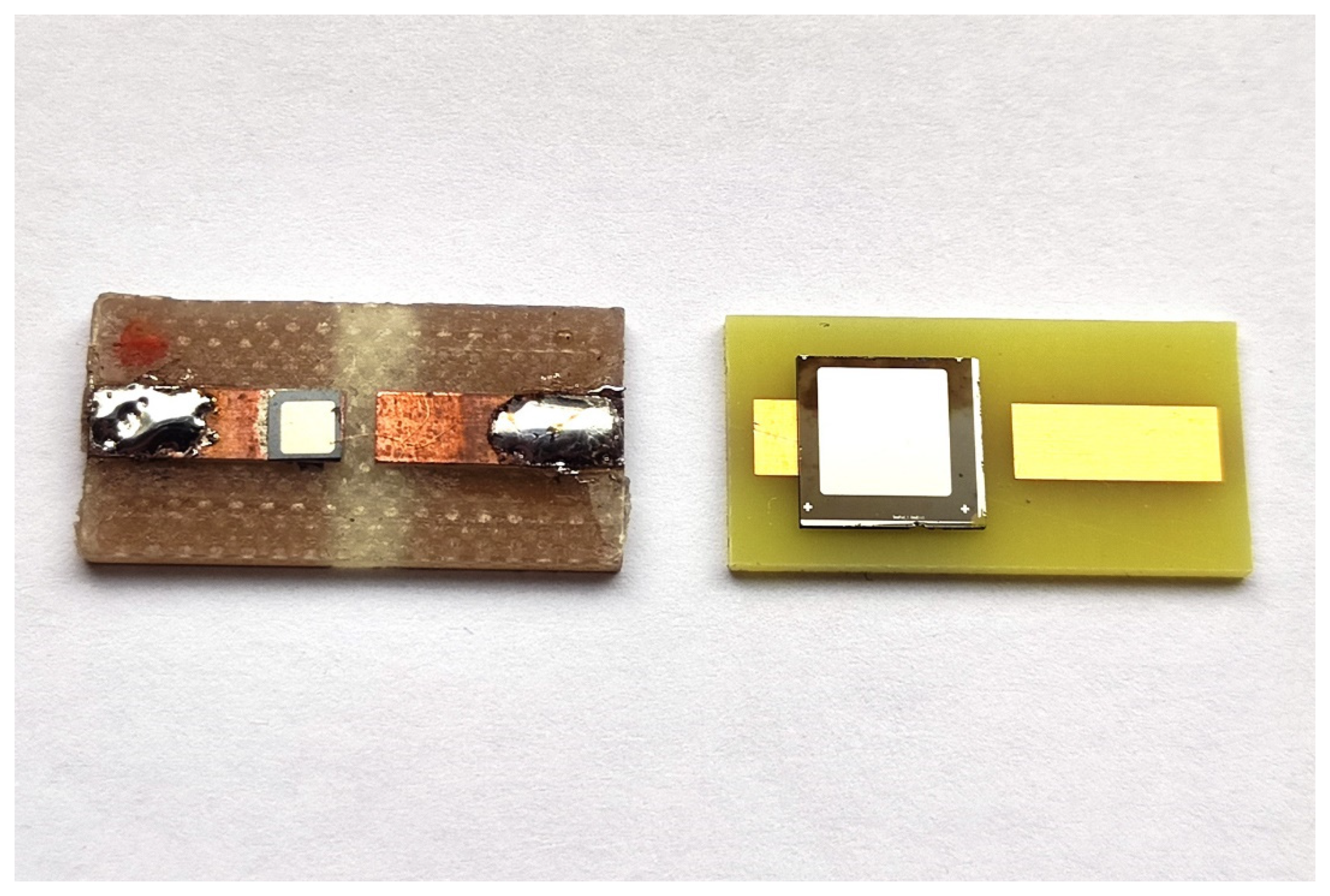
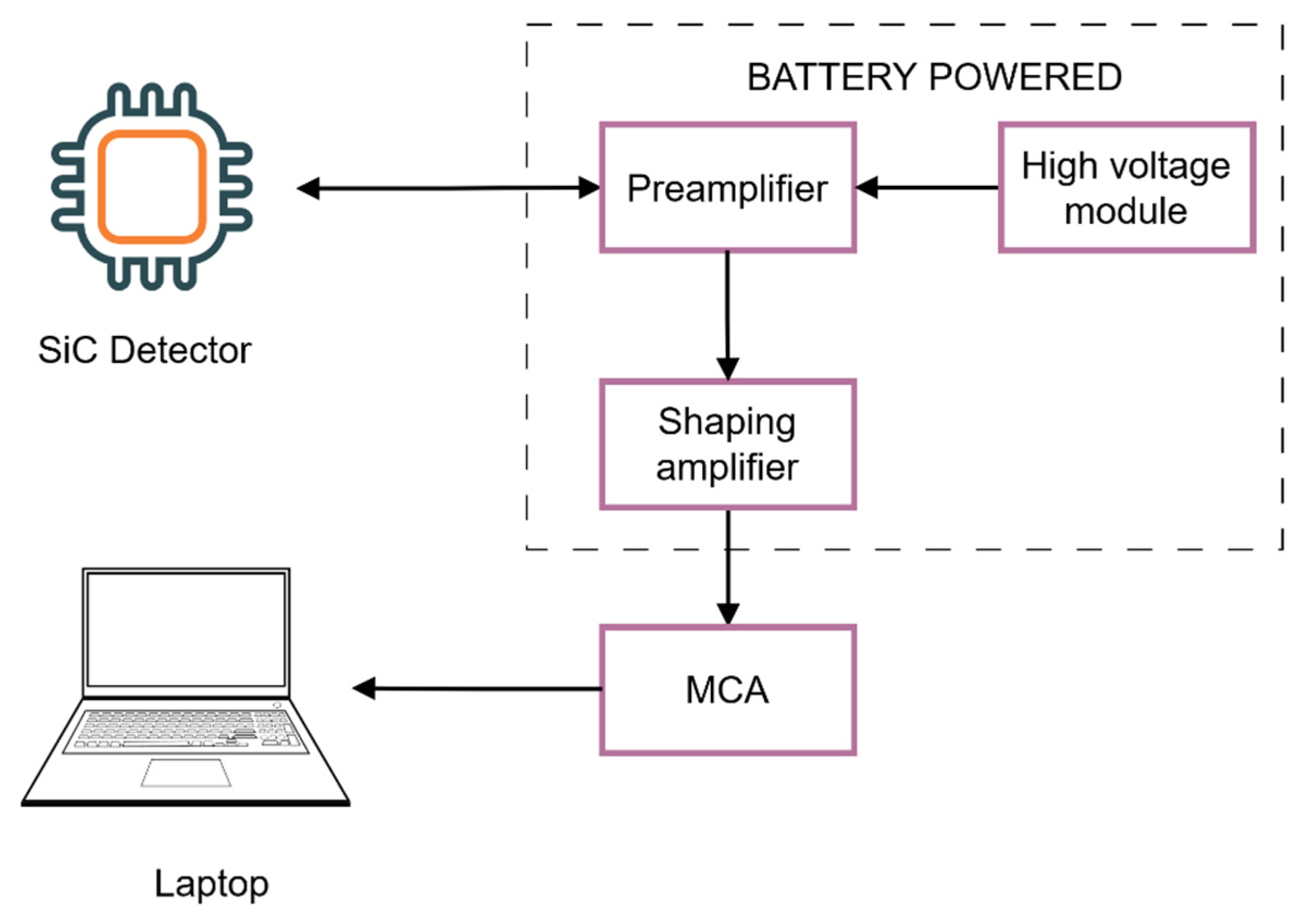
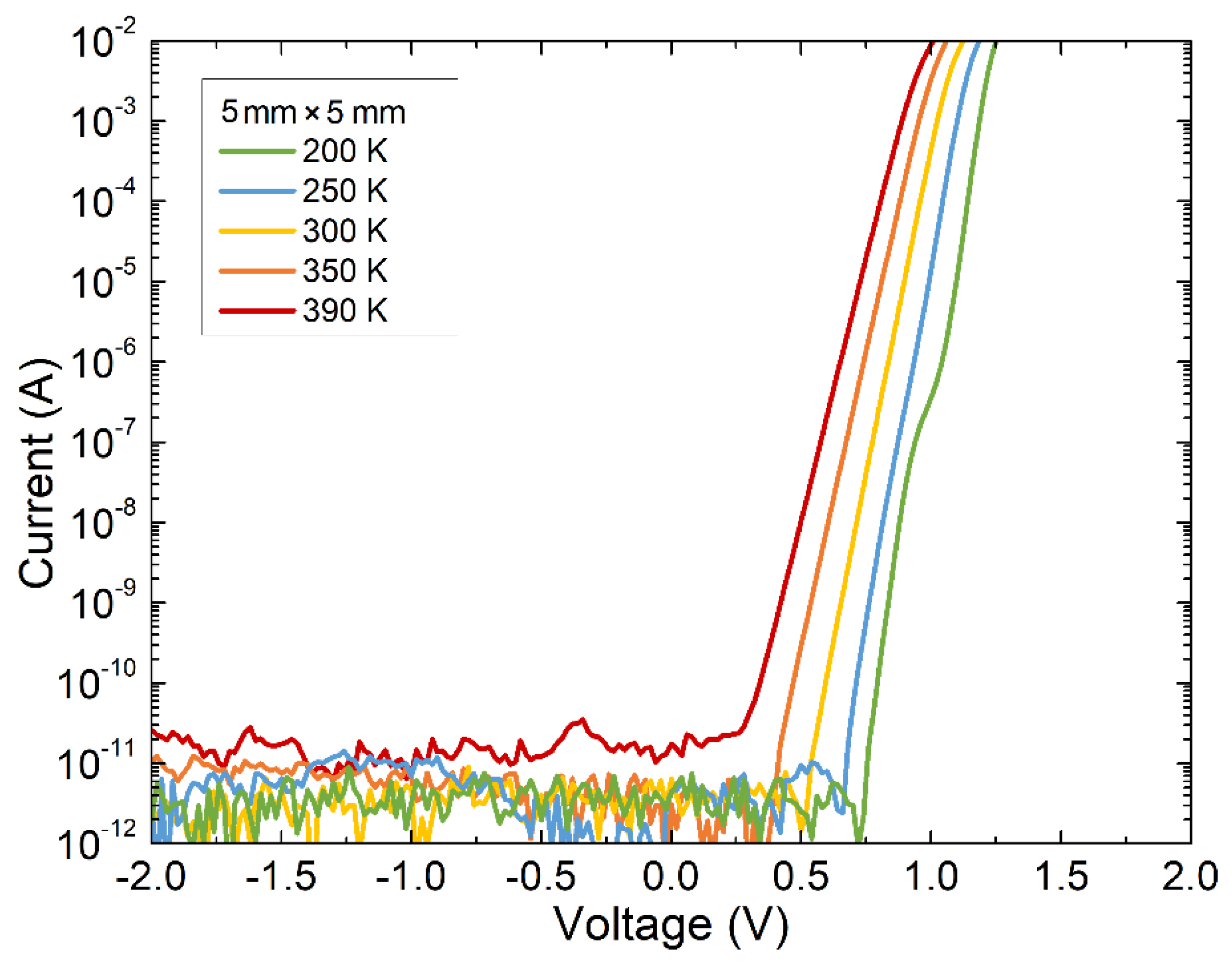

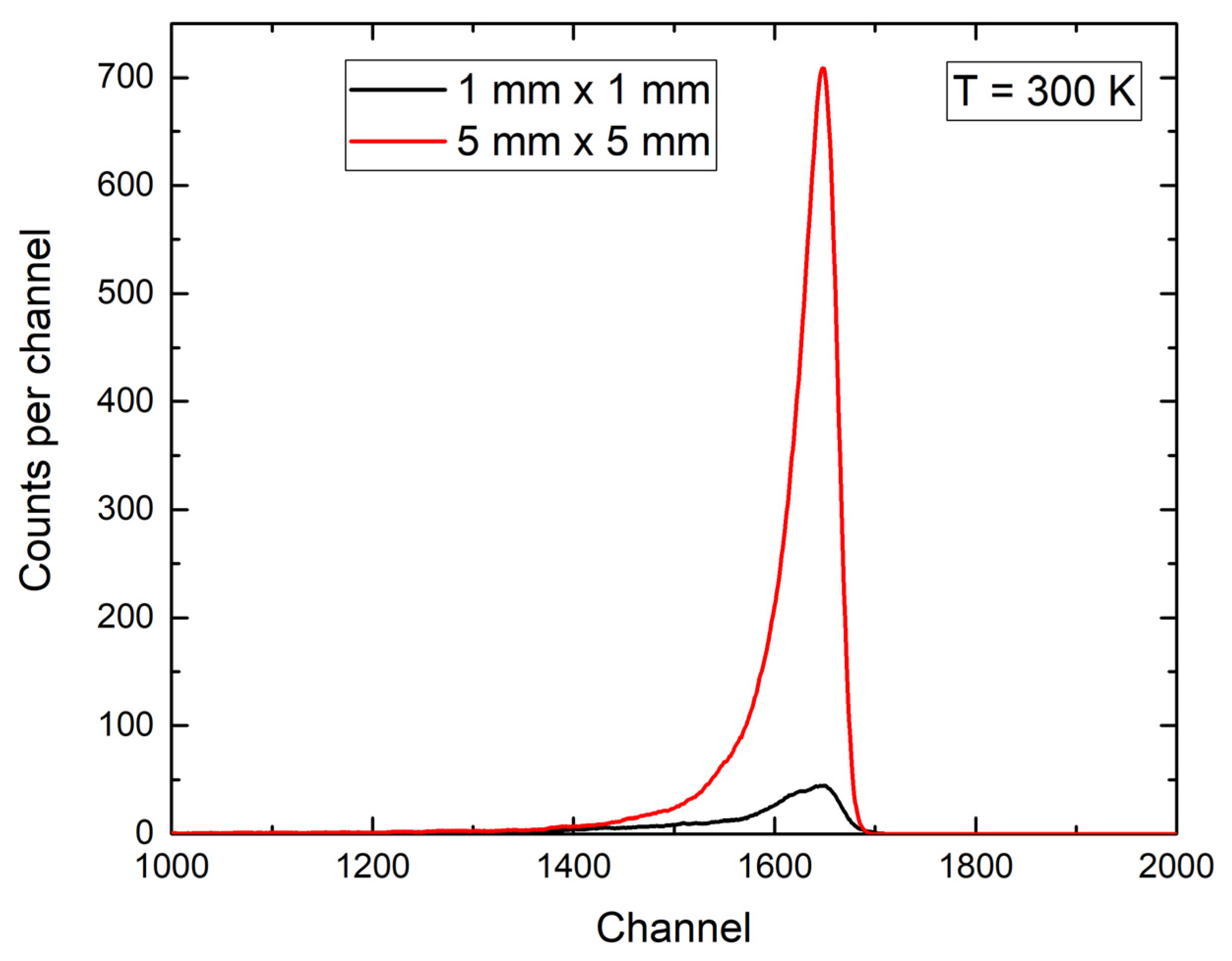


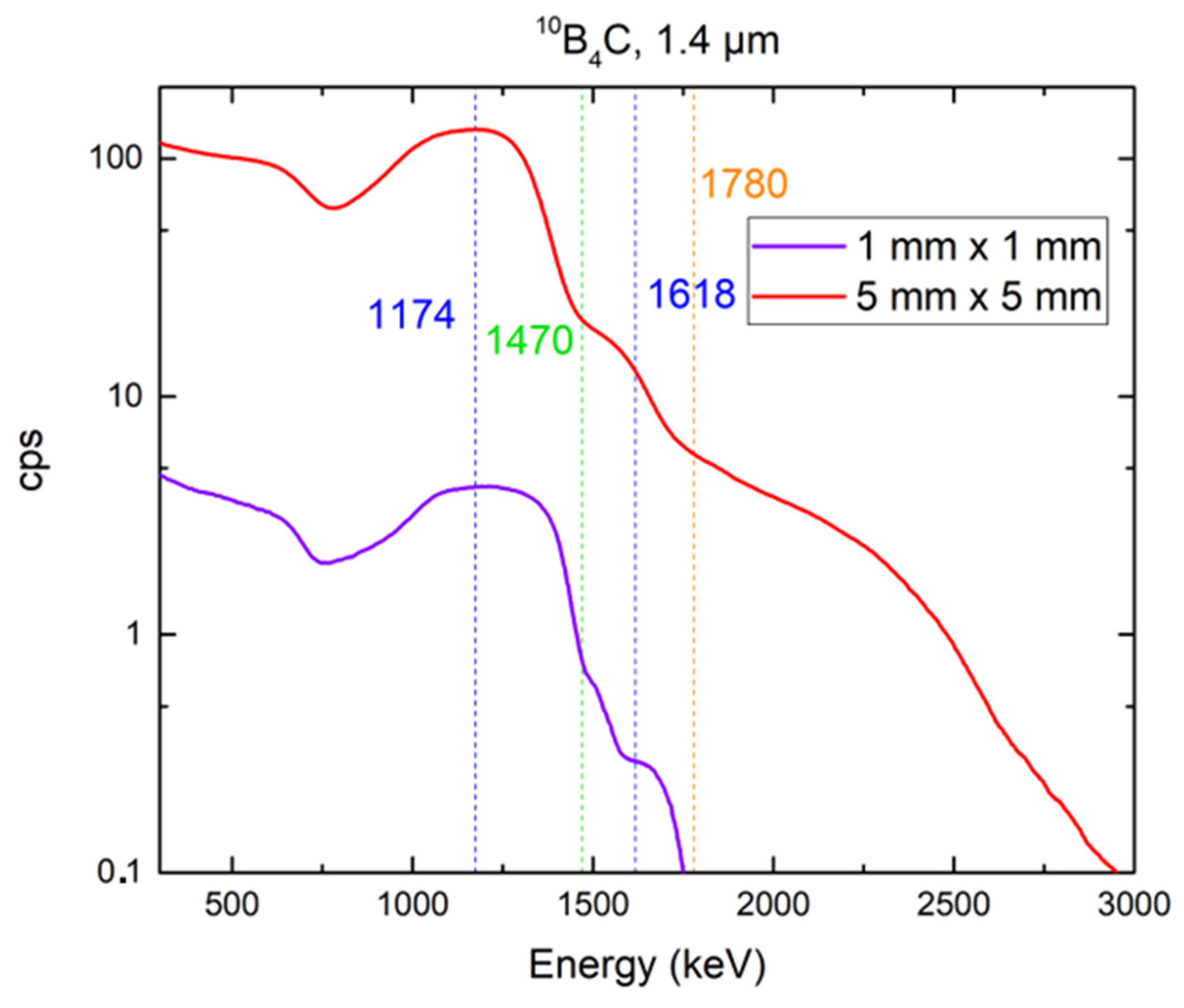
Disclaimer/Publisher’s Note: The statements, opinions and data contained in all publications are solely those of the individual author(s) and contributor(s) and not of MDPI and/or the editor(s). MDPI and/or the editor(s) disclaim responsibility for any injury to people or property resulting from any ideas, methods, instructions or products referred to in the content. |
© 2023 by the authors. Licensee MDPI, Basel, Switzerland. This article is an open access article distributed under the terms and conditions of the Creative Commons Attribution (CC BY) license (https://creativecommons.org/licenses/by/4.0/).
Share and Cite
Bernat, R.; Knežević, T.; Radulović, V.; Snoj, L.; Makino, T.; Ohshima, T.; Capan, I. Radiation Response of Large-Area 4H-SiC Schottky Barrier Diodes. Materials 2023, 16, 2202. https://doi.org/10.3390/ma16062202
Bernat R, Knežević T, Radulović V, Snoj L, Makino T, Ohshima T, Capan I. Radiation Response of Large-Area 4H-SiC Schottky Barrier Diodes. Materials. 2023; 16(6):2202. https://doi.org/10.3390/ma16062202
Chicago/Turabian StyleBernat, Robert, Tihomir Knežević, Vladimir Radulović, Luka Snoj, Takahiro Makino, Takeshi Ohshima, and Ivana Capan. 2023. "Radiation Response of Large-Area 4H-SiC Schottky Barrier Diodes" Materials 16, no. 6: 2202. https://doi.org/10.3390/ma16062202
APA StyleBernat, R., Knežević, T., Radulović, V., Snoj, L., Makino, T., Ohshima, T., & Capan, I. (2023). Radiation Response of Large-Area 4H-SiC Schottky Barrier Diodes. Materials, 16(6), 2202. https://doi.org/10.3390/ma16062202








